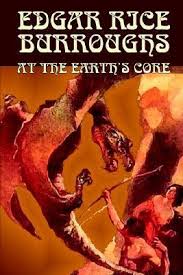Chapter II — At the earths core
byChapter II begins with David Innes waking to a world he cannot recognize, a place that defies every expectation he had of the Earth’s interior. Instead of suffocating darkness or unbearable heat, he finds himself surrounded by a surprisingly hospitable environment. The atmosphere is breathable, the gravity feels lighter, and the sheer scale of everything—from the vegetation to the silence—creates an almost dreamlike effect. At first, fear grips him, especially when he cannot immediately locate Perry. That anxiety is short-lived, though, as Perry is soon discovered nearby, shaken but alive. Their survival itself feels improbable, but their curiosity soon outweighs their confusion. Together, they begin to explore what appears to be a cavernous realm beneath the Earth’s crust. The discovery of a metallic door and the world it leads to astonishes them. A fixed sun hangs high above the horizonless sky, bathing the landscape in eternal light.
This new land is vast and surreal, filled with colossal trees and vibrant vegetation that suggest an ancient, untouched ecosystem. It becomes clear that they are not on the surface world anymore; their surroundings defy any known geography. Perry, ever the scientist, theorizes they have arrived in a hollow Earth, a hypothesis once ridiculed that now seems plausible. The duo’s steps take them toward what appears to be an inland sea, calm and mirror-like, with scattered islands breaking the surface in the distance. Birds with massive wings glide silently overhead, adding to the overwhelming sense of strangeness. Despite the beauty, unease grows. The quiet is too complete, too unnatural, and the lack of shadows beneath the unchanging sun gives the illusion of a frozen moment in time. Then a deep roar fractures that stillness.
A beast unlike anything they’ve seen crashes through the foliage. Towering and brutish, it resembles a prehistoric bear with exaggerated features, its claws like curved knives. Perry stumbles, unable to flee fast enough. David, without hesitation, picks up a rock and shouts, drawing the creature’s attention. The risk is immense, but it works. Perry escapes while David runs, heart pounding, unsure whether his bluff will save them both. The moment marks a shift in David’s character—from passive observer to determined protector. His courage is instinctual, driven more by loyalty than strategy.
Before the creature can strike again, new predators arrive—wolf-like beasts with glistening eyes and bone-crushing jaws. The chaos is immediate. These creatures clash with the bear in a violent frenzy, their howls echoing through the alien forest. The distraction gives David a chance to hide, though not for long. Shadowy figures appear—humanoid but clearly not human. Their skin is darker, their eyes more intelligent, and their movements eerily graceful. David is surrounded, disarmed, and then captured without a word. These beings observe him, speaking in a language he cannot decipher, their curiosity evident.
David is stripped of his clothes and examined with a strange blend of clinical interest and childlike wonder. He is neither tortured nor welcomed. One of them touches his hair, another studies his eyes. Communication is attempted through gestures, but meaning proves elusive. David wonders about Perry—whether he too has been captured or if he managed to escape into the forest. The creature’s earlier attack and the humanoid’s intervention underscore a harsh truth: this world is as dangerous as it is mesmerizing. David’s vulnerability becomes glaringly apparent, and yet he feels the first stirrings of resolve. He will learn. He will survive. He must.
This chapter, though filled with action, serves a deeper purpose. It illustrates a rebirth of sorts for David and Perry—not just into a new land, but into a new way of thinking. Every step they take reveals the layers of this strange inner world, and every danger exposes the strength they didn’t know they had. Their journey has only just begun, but the path forward promises not just survival, but transformation.

